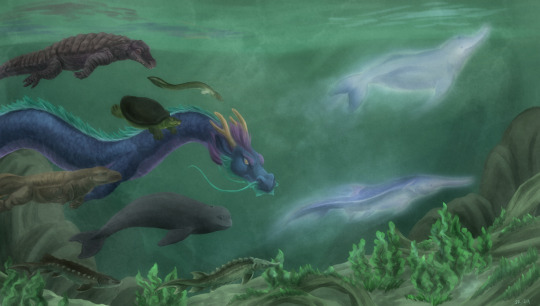#wildlife extinction
Explore tagged Tumblr posts
Text
How a Crisis for Vultures Led to a Human Disaster: Half a Million Deaths. (New York Times)
To say that vultures are underappreciated would be putting it mildly. With their diet of carrion and their featherless heads, the birds are often viewed with disgust. But they have long provided a critical cleaning service by devouring the dead.
Now, economists have put an excruciating figure on just how vital they can be: The sudden near-disappearance of vultures in India about two decades ago led to more than half a million excess human deaths over five years, according to a forthcoming study in the American Economic Review.
Rotting livestock carcasses, no longer picked to the bones by vultures, polluted waterways and fed an increase in feral dogs, which can carry rabies. It was “a really huge negative sanitation shock,” said Anant Sudarshan, one of the study’s authors and an economics professor at the University of Warwick in England.
The findings reveal the unintended consequences that can occur from the collapse of wildlife, especially animals known as keystone species for the outsize roles they play in their ecosystems. Increasingly, economists are seeking to measure such impacts.
A study looking at the United States, for example, has suggested that the loss of ash trees to the invasive emerald ash borer increased deaths related to cardiovascular and respiratory illness. And in Wisconsin, researchers found that the presence of wolves reduced vehicle collisions with deer by about a quarter, creating an economic benefit that was 63 times greater than the cost of wolves killing livestock.
“Biodiversity and ecosystem functioning do matter to human beings,” said Eyal Frank, an economist at the University of Chicago and one of the authors of the new vulture study. “And it’s not always the charismatic and fuzzy species.”
14 notes
·
View notes
Text
A study that just came out demonstrates that outdoor cats are known to prey on over two thousands species of wild animal, from mammals to birds to insects. That includes 347 species that are endangered, threatened or otherwise of concern, and they've been a key factor of the permanent extinction of over 60 species. And while cats may not always bring home what they catch, chances are if your cat is allowed to roam unsupervised outside, they're killing your local wildlife.
Why is this so important? Worldwide, wild animal populations have decreased in number by 69% in the past fifty years; that means that in my lifetime (born in 1978), the sheer number of wild animals in the world has been decreased by over half. Even "common" wild species are less numerous than before. While habitat population is the single biggest cause of species endangerment and extinction overall, outdoor and indoor/outdoor cats are a significant cause as well. In fact, they are the single biggest cause of human-caused mortality in wild birds.
Most importantly, it's very, very simple to fix this problem: keep your cats indoors, and spay and neuter them. If your cat is bored, they need more enrichment, and there are plenty of ways to make your home more exciting for them, from bringing home cardboard boxes for them to explore, to playing with them more often. If you want your cat to get some outdoor enrichment, leash train them (yes, it can be done!) If you have the space and resources, build them a catio where they can be safe from outdoor dangers like predators and cars, while also keeping local wildlife safe from them.
If you just give into their whining and pawing at the door, then they know that that's what they have to do to get their way; I know it's a tough transition, but it's worth it in the end for everyone involved. Cats are domesticated, which means they are not native anywhere in the world; there are exactly zero ecosystems in which they belong, save for the safety of your home. It is your responsibility to give them an enriching environment without taking the shortcut of letting them go wreak havoc outside.
#cats#outdoor cats#feral cats#nature#wildlife#animals#ecology#environment#conservation#science#scicomm#birds#endangered species#extinction#domesticated animals#domestication#biology#animal behavior#animal welfare
8K notes
·
View notes
Text
"Despite being arguably the most famous island chain in the world in terms of biodiversity, the Galápagos Islands are still surprising scientists today.
A bird seen and recorded by Charles Darwin on his visit to Floreana island in 1835 has been observed in the wild there for the first time in 190 years.
Darwin’s observations from the small, south-central island in the volcanic chain included the presence of a small, secretive bird called the Galápagos rail (Laterallus spilonota).
Just two years ago, several organizations began work on the large-scale Floreana Island Restoration Project. By removing invasive species that devastated native wildlife for generations, the local environment once again became a haven for species to recover and thrive.
The Galápagos rail, a land-bird endemic to the archipelago, has been severely impacted by these invasive species. It dwells on the ground, is extremely vulnerable to predators, and relies on dense, lush vegetation to hide in. But despite these dangers, the rail has proved to be a resilient and resourceful little bird.
The rails, locally known as Pachays, have been quick to return to restored islands. In 2018, six years after the conservation nonprofit Island Conservation successfully removed invasive species from nearby Pinzón Island, the Rails were among the first locally-extinct animals to reappear—along with other species such as the cactus finch.
It hasn’t been long since the Floreana Island Restoration Project began, but the rails have already repopulated it.
During their most recent annual landbird monitoring expedition on the island, teams from the Charles Darwin Foundation and Ecuador’s state agency for managing the archipelago recorded the bird’s presence at three distinct sites.
The birds were present and away from human habitation and agriculture, in a grassland shaded by guava trees. Confirmed findings include six acoustic records, two visual sightings, and one photograph. And it isn’t a coincidence that they’re back now—the site has been monitored for the Galápagos rail consistently since 2015, and this is the first year they’re back.
“The rediscovery of the Galápagos rail confirms what we’ve seen on islands worldwide—remove the invasive threats, and native species can recover in remarkable ways,” said Island Conservation’s Conservation Impact Program Manager Paula Castaño in a statement.
“This is an incredible win for Floreana, and fuels our excitement about what other native species might resurface as the island continues its journey toward ecological recovery.”
Next, scientists must use genetic sampling to determine whether these newly recorded birds are from a self-reintroduced lineage or whether there was a tiny population of rails that survived, undetected, for 190 years.
Island Conservation details how that’s not unheard of: on nearby Rábida, the organization’s restoration efforts led to the rediscovery of a species of gecko that was only known to science through subfossil records dated more than 5000 years old. They’d been living on the island in very low numbers for hundreds of years, but it was only once holistic restoration had taken place that they were able to increase their numbers to detectable levels.
MORE NEWS FROM THIS FAMOUS PLACE: 500 Giant Tortoises Reintroduced to Four Galapagos Islands in 2023
With a local population already establishing itself, chances are good for a successful reintroduction. Soon, it’s hoped, Floreana’s grasslands will be home to a large, thriving colony of rails.
“It gives us hope that there might be even more ‘extinct’ Galápagos species to find,” the statement read.""
-via Good News Network, March 3, 2025
#galapagos#galapagos islands#birds#birdblr#endangered species#extinction#conservation#extinct#ecosystem#wildlife conservation#good news#hope
685 notes
·
View notes
Text

Ancient Auroch Skull, Bos primigenius, Perth Museum, Scotland
Aurochs are the wild ancestor of domestic cattle. Destruction of forests and hunting over thousands of years led to their extinction. The species survived in Britain until the Bronze Age.
This skull was found at Chapleton Moss, east of Forfar, Angus in 1790.
#ice age#bronze age#stone age#iron age#prehistoric#prehistory#neolithic#mesolithic#paleolithic#archaeology#cattle#aurochs#wild#extinction#nature#wildlife#Scotland#skull
414 notes
·
View notes
Text

There's a Banksia woodland nearby where I live. It's almost untouched by humans (no paths, litter, etc, only a few weeds here and there, but not many) and has extremely high biodiversity, characteristic of this ecosystem.
I visited it the other day and sat beneath the glorious, low-lying canopy of Banksia attenuata, and began imagining a thylacine prowling through the bushes looking for bandicoots as they would have done 2000+ years ago here in Noongar country.
#my art#art#digital art#spiritual art#thylacine#extinct animals#extinct species#thylacine art#tasmanian tiger#tasmanian wolf#australian wildlife#australia#banksia#artists on tumblr
414 notes
·
View notes
Text
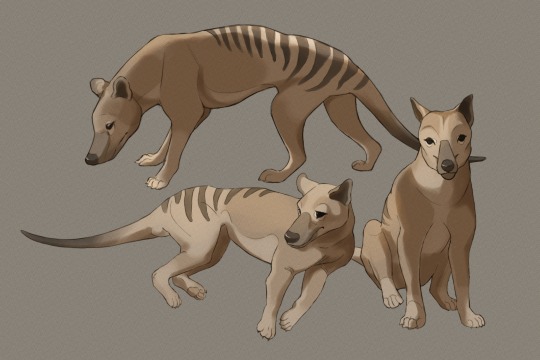
Thylacine studies from the colorized footage.
#thylacine#tasmanian tiger#tasmania#extinct species#extinct animals#wildlife illustration#wildlife art#marsupial#animal art#zoology#animal studies#animal artist#tasmanian wolf#australia#australian wildlife#australian animals
807 notes
·
View notes
Text
Barbary Lion

A study of the Last photo of a wild Barbary lion, Atlas Mountains, 1925. photo taken by Marcelin Flandrin
87 notes
·
View notes
Note
saw these again at campus and thought I'd send them in !!!



Oh that's so cool, ty for sharing!! We had a Thylacoleo skull replica at my campus, which was pretty neat eve
I wish i had a replica of my own for tricky angles. I keep being tempted to buy myself a Bone Clones Smilodon but augh, postage is hellish from the US 😭
Side note: i really must wonder why people (in science no less) still use Prehistoric Wildlife's ugly af size charts?? JFC their proportions look nothing like the actual animals?? How can you get a LION that wrong fjhdjdjd??
Like, Prehistoric Fauna is Right There with this:

Which is gorgeous! And omg, they look like animals XD
Ok rant over and ty again for showing me your campus skulls!!! <3
#sorry for the mini rant i just can't comprehend why Prehistoric Wildlife's stuff is still used in museums and stuff#the average guy with a lion silhouette could do better i s2g 💀#also @ the Dire Wolf ask- im getting to it but Ho Boy you opened a can of worms asking my paleo ass about de extinction (or not bc it isnt)#paleo stuff#smilodon#panthera leo atrox#panthera atrox#american lion#sabercat#sabertoothed cat#sabertooth tiger#sabertooth#mammothask#marchnemesis#ooc ask#clangen#described#id in alt text
64 notes
·
View notes
Text
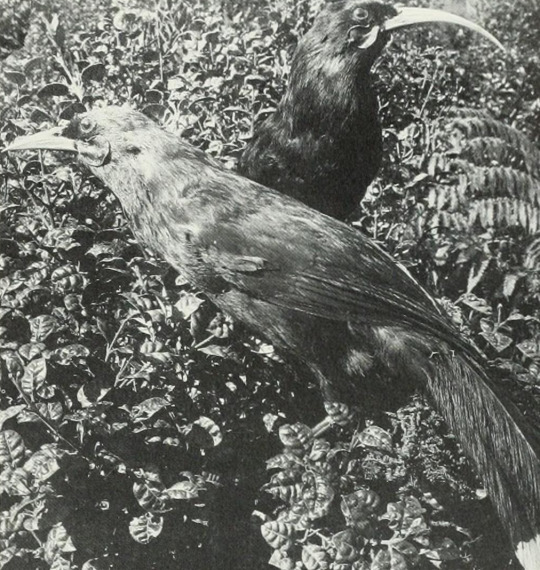
Taxidermy huia birds By: Unknown photographer From: Man and Wildlife 1970
89 notes
·
View notes
Text
Round 3 - Reptilia - Phoenicopteriformes




(Sources - 1, 2, 3, 4)
Our next order of birds are the Phoenicopteriformes, commonly called “flamingos”. They are comprised of one family, Phoenicopteridae, and 3 genera.
Flamingos are most well-known for having varying degrees of pink coloration derived from their diet. Young flamingos hatch with grayish plumage, but adults range from light pink to bright red due to aqueous bacteria and beta-carotene obtained from their diet of blue-green algae (phylum Cyanobacteriota), diatoms, and/or small invertebrates such as Brine Shrimp (genus Artemia). Some species, such as the American Flamingo (Phoenicopterus ruber) (image 1) tend to be more reddish-pink due to a greater availability of beta-carotene, while other species are a more pale pink due to ingesting a smaller amount of the pigment. Due to their filter-feeding diet, flamingos have unique bills which are specially adapted to separate mud and silt from the food they eat, and are used upside-down. Hairy structures called lamellae line the bill and tongue, filtering out food particles. Flamingos have long necks and legs. Their feet are webbed to aid with swimming and to stomp their feet in the mud to stir up food from the bottom. They live in tropical areas in the Americas, Africa, and Eurasia, typically in saltwater lagoons or high saline freshwater environments. Though flamingos prefer to drink freshwater, they are equipped with glands under their eyes that remove extra salt from their bodies. This organ allows them to drink saltwater as well, and many flamingo species are extremists: animals which live in extreme environments that many other organisms can not survive in.
Vocalizations play an important role in parent-chick recognition, ritualized displays, and keeping large flocks together, and flamingos are quite noisy. They are very social birds, and live in colonies whose population can number in the thousands. Before breeding, flamingo colonies split into breeding groups of about 15 to 50 birds. Both males and females in these groups perform synchronized ritual displays, which involve stretching their necks upwards, head-flagging, and flapping their wings (see gif below). The displays do not seem directed towards an individual, but occur randomly, and help pair up those birds that do not already have mates. Flamingos form strong pair bonds, though in larger flocks they may change mates due to having more options. A pair will establish and aggressively defend a nesting site, usually from other flamingo pairs trying to commandeer it. The nest is typically made of mud, into which the female will lay one large, chalky-white egg. Both the male and the female contribute to building the nest, and to protecting the nest and egg. For the first six days after the chick hatches, the parents and chick stay in the nesting sites. Both the male and the female feed their chick with a kind of crop milk, produced in glands lining the upper digestive tract. Crop milk contains both fat and protein, as with mammalian milk, but unlike mammalian milk, it contains no carbohydrates. At around 7–12 days old, flamingo chicks begin to move out of their nests and explore their surroundings. When they are 2 weeks old, the chicks congregate in groups, called "microcrèches", and their parents leave them alone. After a while, the microcrèches merge into "crèches" containing thousands of chicks, which are marshaled by a few adults. When young flamingos are around 3 to 3.5 months old, their flight feathers will finish growing in, allowing them to fly and join the main flock.
Phoenicopteriformes evolved in the Eocene, with modern flamingos, such as Elornis, appearing in the Oligocene, around 25 million years ago. They form a clade, Mirandornithes, with the grebes (order Podicipediformes), and the ancestor of both orders was likely highly aquatic.

Propaganda under the cut:
Flamingos often form same-sex pairs, and may adopt orphan eggs or even steal eggs from other flamingos to raise as their own.
Flamingos are known for standing on one leg with the other tucked against the body. Many birds do this behavior, though it is most noticeable in flamingos due to their long legs. Standing on one leg allows the bird to conserve more body heat, and reduces energy expenditure, as the one-legged pose can be held without any muscle activity.
The Greater Flamingo (Phoenicopterus roseus) (image 3) is the tallest of the six species of flamingos, standing at 1.2 - 1.4 m (3.9 - 4.7 ft) tall with a weight up to 3.5 kg (7.7 lbs).
One of the oldest flamingos in the world was Greater, a Greater Flamingo who lived at the Adelaide Zoo in Australia. Greater was euthanized January 2014 (they were arthritic and their health was deteriorating rapidly) at the age of (at least) 83 years old. Greater Flamingos usually live to about 60 years in human care, and 30–40 years in the wild.
The near threatened James's Flamingo (Phoenicoparrus jamesi) (image 2) was once thought to be extinct until a population was discovered in a remote area in 1956.
Many species of flamingos are threatened. The main threat is loss of habitat, as flamingos require specific habitats to live and feed in; habitats considered of little use to humans. The loss of one saltwater lagoon or soda lake can be a huge blow to a flamingo population. They are also threatened by commercial mining activities, poaching of eggs, and climate change raising the water levels, hindering their ability to access food.
#I read a short story in Ranger Rick as a kid about a world where flamingos were extinct or near extinct and this kid dreamed of seeing one#The story ended with the kid thinking they found a whole flock of them to slowly realize they were all plastic lawn ornaments#The metaphor of replacing wildlife with plastic has stuck with me my whole life#animal polls#round 3#reptilia#Phoenicopteriformes
57 notes
·
View notes
Text





" The Markhor " // © Chris Henry
#Karakoram#Himalaya#Pakistan#India#China#nature#Portrait#Wildlife#Goat#Markhor#Species#Rare#Extinction#Conservation#Endangered#photography#aesthetics#wanderlust#explore#follow#discover
64 notes
·
View notes
Text
Excerpt from this story from The Revelator:
In southern Brazil, especially the state of Rio Grande do Sul, severe flooding has caused an emergency being reported around the world. Human losses and homelessness there represent the biggest socioenvironmental catastrophe affecting the country.
One aspect that hasn’t yet garnered much media attention is the impact of these floods on rare and at-risk wildlife. For 11 years I worked on Marinheiros Island, situated on the estuary of Patos Lagoon in the heart of the now-flooded areas. On this island I identified the presence of three species of small vertebrates threatened with extinction, whose populations there are of great conservation importance.
Patos Lagoon is the most extensive lagoonal system in the world. Within this estuary Marinheiros is the largest island, covering an area of about 62 square kilometers (24 square miles).
Even before the current crisis, over the past few years, Marinheiros has experienced harsh flooding associated with massive rainfall. The floods are even more intense during El Niño phenomena, which produce heavy rain in southern Brazil. Three main factors there, together, result in the rapid rise of estuarine water levels and consequent flooding of the lagoon’s islands and marginal mainland:
The low elevations of marginal areas.
Heavy rains that increase the flow of rivers into the Patos Lagoon system and the subsequent discharge of water in the choked estuary.
Wind directions against the water flow from the estuary to the Atlantic Ocean, acting as a barrier for water discharging into the ocean.
The year 2023 saw a severe flood in Marinheiros Island and the marginal mainland of the Patos Lagoon estuary. This year has been even more calamitous. Flooding of 70% of the municipalities of Rio Grande do Sul — which includes the whole extension of the Patos Lagoon marginal zone — has, as of this writing, caused 149 people to lose their lives and forced more than 615,000 to leave their homes. Many of the more than 1,100 inhabitants of Marinheiros Island were rescued and sent to temporary shelters.
But rescuing the wildlife of Marinheiros Island has not become a priority. Three species deserve to be highlighted due to their very restricted distribution, habitat specificity, and conservation status.
A Toad, a Glass Snake and a Guinea Pig
The tiny red-bellied toad (Melanophryniscus dorsalis) — with a body length about 2 centimeters (just .78 inches) — can be considered a flagship species of Marinheiros Island.
The species’ existence on the island was only discovered in 2006, and it’s the southernmost known population of the species. Red-bellied toads are restricted to the coastal, marshy fields of the Brazilian states of Rio Grande do Sul and Santa Catarina and are considered threatened both regionally and nationally.
The estuarine glass snake (Ophiodes enso) was described only in 2017, and it is known from only three localities in the estuary of Patos Lagoon, one of which is Marinheiros Island. Like other reptiles commonly known as “glass snakes,” these animals are, in fact, legless lizards.
This species’ conservation status has not yet been officially evaluated by specialists at national and global levels. In the paper on the species description, however, Ophiodes enso is suggested as “critically endangered” given the small area of occurrence and the human-induced impacts on its habitats.
Finally, the greater guinea pig (Cavia magna) is a medium-sized rodent with a body length reaching 30 centimeters (about 1 foot). It lives on the borders of marshes and wet fields of a narrow coastal strip of Uruguay and southern Brazil’s Rio Grande do Sul and Santa Catarina states.
The species is classified as “endangered” in Uruguay and “vulnerable” in Rio Grande do Sul. Importantly, greater guinea pigs from Marinheiros Island are genetically distinct from other populations in terms of the number of chromosomes (individuals from Marinheiros Island have 64 chromosomes, while mainland populations have 62).
3 notes
·
View notes
Text
This is such a cool story! Conservation of endangered species cants heavily toward animals and then plants, but you rarely see efforts to try to help endangered fungi, lichenized or otherwise. Part of this is because many fungi are very difficult to propagate, particularly those that have mycorrhizal relationships with plants, and so the best way to save them is to protect critical habitat for those species. Moreover, fungi that produce fruiting bodies like mushrooms are only really easy to observe during their relatively short fruiting season, so unless you're searching the soil or other substrate for DNA traces, your window to actually survey rare fungi is quite short.
But lichens are different. They persist year after year, and so are easier to observe. Growing them is another story, though; most people who give it a try put fragments of a given lichen on a favorable substrate in a controlled environment and hope for the best. However, success is relatively rare in the long term as lichens are quite persnickety about their growing conditions.
So what about just moving the whole substrate? If you have lichens that conveniently grow on tree branches you could cut off piece of branch and then attach them to branches of the same species of tree elsewhere at the same height/sun exposure/humidity level, and hope that the lichens continue to produce spores that then find favorable substrates locally. But it's tougher to chip off chunks of rock and move them to new places, especially if you don't want them getting kicked around.
So it's really fascinating that these conservationists tried out all sorts of different glues to find the most lichen-friendly ones, and then glued them to new substrates in old parts of their range in the hope that they'll use their rhizines to attach themselves to their new homes. It shows how much detail we have to go into in habitat restoration and species conservation to try to replicate the best conditions for a given species to thrive, and how we can't just offer degraded habitats to our wildlife of various sorts and hope that they find it acceptable. Lichens like various Parmelia species or Evernia prunastri may not be as picky in their substrates, but for a rarer species like Gyalolechia fulgens, our task is to give them their Goldilocks substrate--just right. And sometimes helping them along involves a little bookbinding glue.
#lichens#fungi#endangered species#extinction#conservation#restoration ecology#habitat restoration#nature#wildlife#environment#environmentalism#scicomm#good news#positive news#bookbinding#books#ecology#hopepunk
1K notes
·
View notes
Text
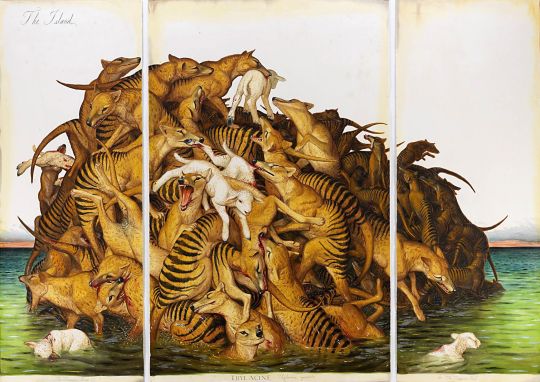
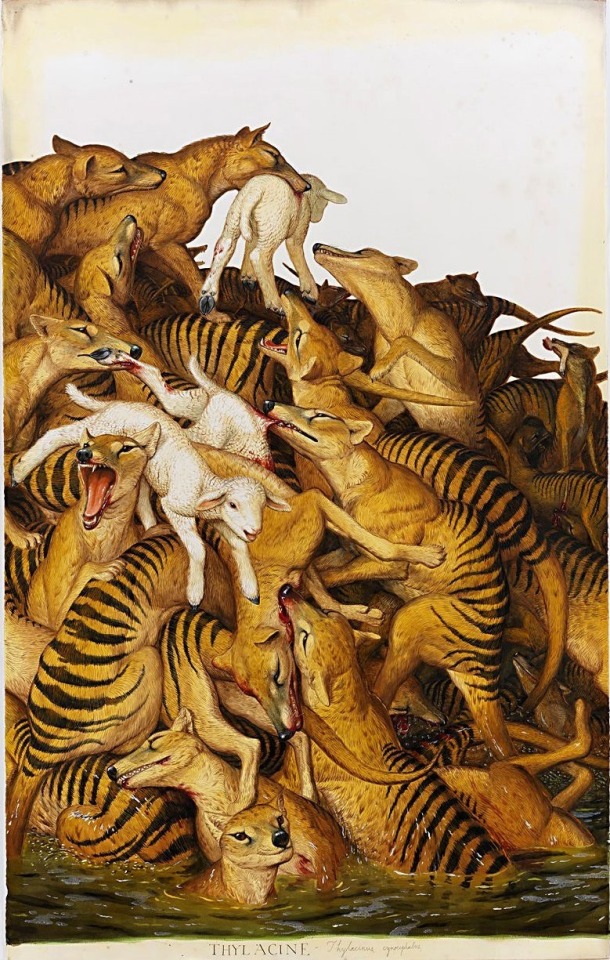
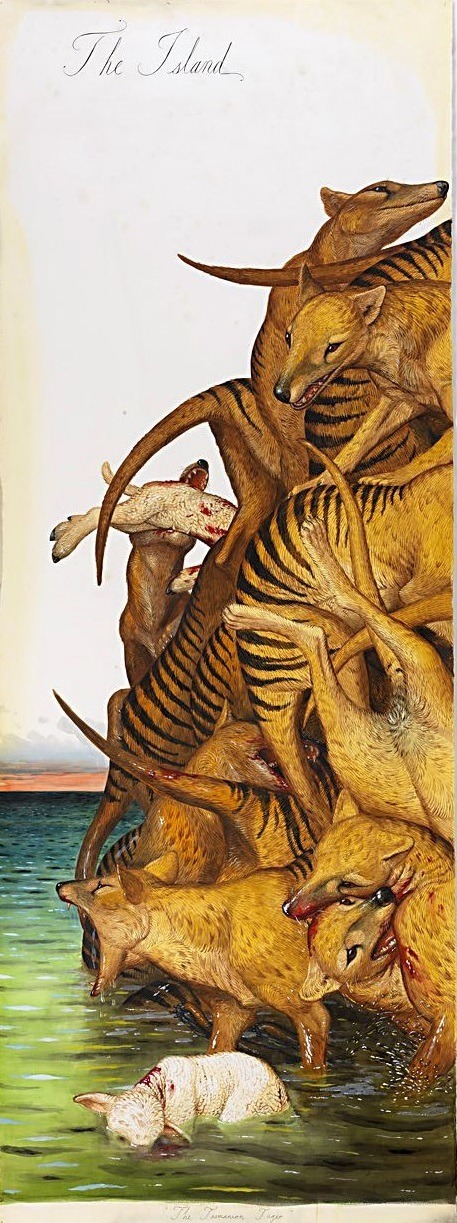
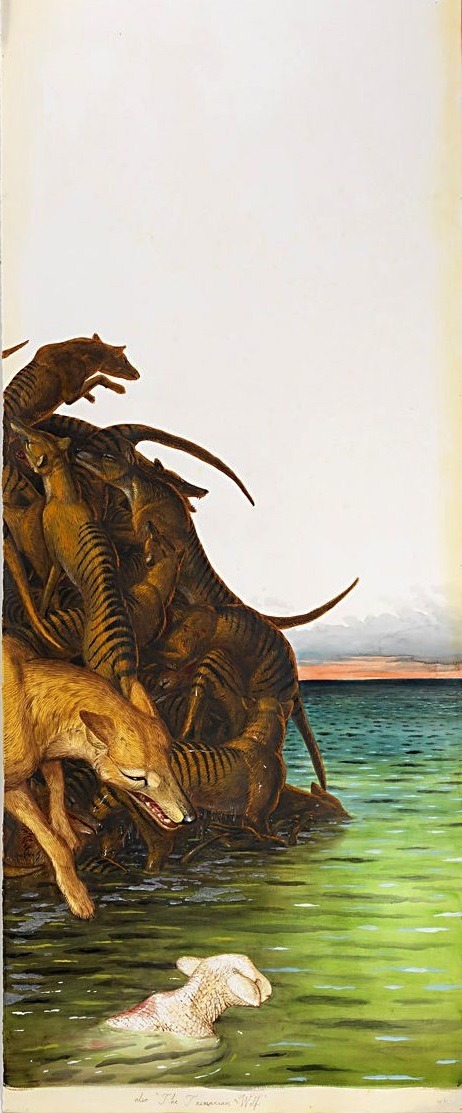
The Island by Walton Ford
982 notes
·
View notes
Text

Since it's close to US election time my only comment will be to share this chart showing the number of species given protection under the Endangered Species Act per year.
Note that giving a species protection helps give it protected habitat and hopefully prevents its extinction.
#endangered species#us elections#hopepunk#kamala harris#climate action#environment#climate crisis#extinction#conservation#wildlife conservation#biodiversity#sixth extinction#environmentalism
76 notes
·
View notes
